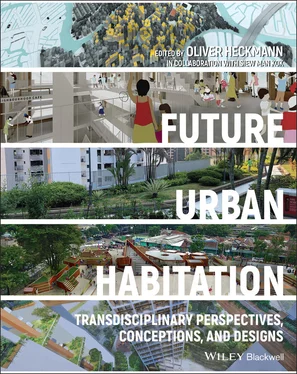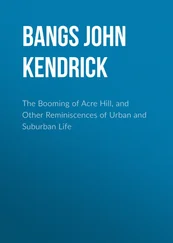In urban habitation, multiple local and global stakeholders are involved: policymakers and investors, profit‐ or non‐profit‐driven housing developers, designers from various fields, other specialists from engineering or industry, community workers and activists, and last not least the dwellers themselves. Their agencies, interests, and expertise can either find mutually beneficial liaisons or cause disruptions and have to be balanced and moderated accordingly. This publication includes essential transdisciplinary perspectives of experts from some of these fields: designers working on an architectural and urban scale or on social design agendas illustrate innovative concepts for urban habitats and their operations. Practitioners and researchers working on the needs of vulnerable population and the facilitation of social and health services discuss new concepts for social practices. Representatives of public housing boards and social administrations share about sustainable policies for affordable and inclusive urban habitation. Field‐working sociologists and anthropologists share about their perspectives how anticipating of diverse and dynamic urban communities could inform inclusive design approaches and replace normative paradigms. Design and engineering researchers from practice and academia demonstrate new capacities emerging with expertise on social design, sustainable construction or circular economy, and innovative tools for parametric design or performance simulation. Most of the authors conduct their practice and research beyond siloes, with either cross‐disciplinary communication and knowledge exchange or interdisciplinary collaboration. They emphasize also with their contributions, how important encounters between experts from various fields are and how essential research as integrative component is to strive for greater impact with their projects.
Four key questions are raised in respective book sections: How can we cater to inclusive cities enabling equal participation of all, considering that sustainable concepts for habitation must begin at an urban domain with both its social and spatial dimensions?
How can built forms and their social life engender community and sense of belonging in both new developments and additions to existing socio‐spatial contexts, in view of increasingly diverse, dynamic, and segregated societies?
How can habitats adapt to shifting demographics, not only offering appropriate shelters for more diverse and dynamic forms of cohabitation and appropriation of spaces, but also respond to growing care‐gaps, and to initiatives for mutual engagements, calls for agencies and new forms of coexistence?
How can those working on these questions employ themselves with better insight, tools, and methods to aim for social and environmental sustainability, and how does this affect design‐thinking and decision‐making?
Each of the sections is introduced by me with a discussion of the respective challenges at stake and of some exemplary frameworks and projects offering solutions. Given the complexity of the themes these introductions are not meant to be a full literature review or comprehensive summary but to tie together a narrative of current debates and examples, that help to contextualize the contributions of the authors for readers from different fields. Likewise, the intention of the chapters in each section is also not to give a complete overview but to rather illustrate and share exemplary contributions and perspectives by authors from different angles, fields, and localities. Their interrogations help to decipher and understand the larger mechanisms behind, which can often be related to the global challenges raised above. While the proposals elaborated in the chapters might not be applicable one to one to the specific circumstances of other places, they can point at possible avenues.
The multifaceted aspects of what inclusion‐minded practices should entail have been iterated in critical research, planning guidelines, and frameworks on inclusive design: Independent of one's individual abilities or status, everybody should have equal access nearby to diverse, affordable housing, fair employment, places of consumption, public facilities such as for education or healthcare and other infrastructure. Having a stable home is at the core of both individual and collective liveabilities, necessitating also the abilities to age in place or raise children safely, to mention a few. Beyond the mere provision of safety and affordability, inclusivity must also empower to equal participation in the social, economic, and political opportunities that cities entail.
But while cities might ideally be places bringing together different people, capabilities, classes, backgrounds, expertise, and markets for their mutual benefits, cities and urban habitats emerged increasingly as ‘arsenals of exclusion’ (Armborst et al. 2017), with often systemic policies, practices, and places, that are deliberately instrumental in preventing or even withdrawing equal access to the potentials urbanism entails – by excluding citizens because of their race, income, status, nationality, education, or sexual orientation, to mention a few.
With neoliberalism and the local impacts of global finance, the withdrawal of welfare states as instrument to re‐balance pressing societal inequalities, cities and their habitats are ever more threatened to become conflicted, exclusive territories. The commodification of housing and lack of affordable dwellings as a consequence, the radical impacts of shifts in global production on the socio‐economic fabric in cities, and the complex consequences of global migrations due to climate change or conflicts threaten ever broader groups with the complex uncertainties of exclusion: both those, that would depend even more on the capacity of habitats for their inclusion like vulnerable populations, but increasingly also those that were always considered to be safely integrated within their neighbourhoods.
The authors in this section illustrate alternative ways how future urban territories could be conceptualized to cater to inclusive, empowering and sustainable collective living.
Policymakers and researchers from the Barcelona City Social Rights Department and the Institute for Regional and Metropolitan Studies in Barcelona illustrate their essential role as both innovators and implementors of inclusivity‐driven policies. They share about redesigning services for the care of elderly and the creation of solidarity ties. With the pursuit of ‘integral superblocks’, strategic connections between physical and social aspects are drawn to move towards new social city models.
Sociological perspectives on inclusion in Singapore are raised by Vincent Chua, a sociology professor at National University of Singapore, as a socially diverse city where network segregations occur along domains like education and housing. Given the lack of welfare policies other means for an inclusive society are discussed: voluntarism to enhance social capital, community building based on acceptance of diversity, and joint debates on common frames of reference.
The Social Urban Research Group based at Singapore University of Technology and Design shares about research and initiatives for participatory place‐making and ‐keeping opportunities for marginalized groups, aiming for social integration, community empowerment, and co‐creating processes through both web‐ and site‐based platforms.
Inclusive design strategies for sustainable urban revitalization and local interventions as catalysts for social innovation are presented by the architecture firms LOHA in projects for Detroit and SHAU for Indonesian cities, with both employing integrative roles as designers, researchers, initiators of change, and moderators between numerous agencies. They consider architectural interventions as potential agencies to ‘design coexistence’ contributing to an open city. Based on community workshops and other participatory practices, their projects entail community framework plans, programming initiatives as well as small‐scale interventions, as community‐driven responses to imminent needs and initiatives.
Читать дальше












